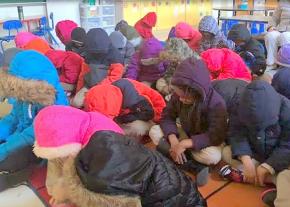Classrooms where it’s too cold to learn
, a parent of a Baltimore City Public Schools student, describes the long-term crisis that looms behind reports of children suffering in freezing classrooms.
BALTIMORE CITY Public School students and teachers have been sitting and working in classrooms without heat for years.
It's happening again this winter, and for some reason--perhaps because of social media, perhaps because this is the coldest winter we've had since the uprising after the police murder of Freddie Gray in 2015--it's become national news.
As a parent of children in Baltimore City Public Schools, I know a little bit about the health and safety crises created in a school with inadequate heat.
Pipes freeze and burst when they thaw--sending water streaming unexpectedly through the building. Sometimes, water for the entire building needs to be turned off. This doesn't impact drinking water, because everyone knows the water is unsafe to drink due to lead contamination. But it does impact sanitation.
Lower-level floors and elevator shafts flood. Last week, photos circulated online of the exterior of a school with streams of ice pouring out the windows on the first and second floors and cascading down the side of the building.

Photos have also circulated online of children huddled on the floor, wearing winter coats, hats and scarves in an attempt to stay warm.
In my experience, children are remarkably forgiving and adaptable. I do wonder, however, about the psychological impact of being made to go to school in a facility that seems to say that it hates you.
In a January 4 New York Times article on the crisis, Baltimore City Schools CEO Sonja Santelises was quoted as saying, "Nobody in this city, including me, wants folks sitting around in coats and mittens all day for the entire week." I wonder how much of a day would be acceptable for the CEO? Maybe a few full days, but not an entire week?
The building in the ice cascade photo last week was Harlem Park Elementary/Middle School. Harlem Park had previously been known as the neighborhood where, in December 2017, a police detective was shot to death the day before he was scheduled to testify against a squad of indicted officers.
Before that, the school was known as the building where, in 2016, a white teacher was filmed screaming at a room full of Black students that if they didn't listen to her, they would become "a punk-ass n----- who's going to get shot."
IN PROGRESSIVE education circles, educators talk about the classroom environment being "the third teacher." What are these environments teaching? What are the children learning from them? There are many dynamic and inspiring young activists in Baltimore city, but I think the price is too high.
We adults also have a responsibility to act, and there are teachers doing great work in the Baltimore Teachers Union and Baltimore Movement of Rank-and-File Educators, which has created an online petition.
There is a GoFundMe campaign promoted by teacher Aaron Maybin to buy coats and space heaters. While the donations are no doubt heartfelt and generous, $80,000 for space heaters comes nowhere near to meeting the school system's needs.
Because, in fact, Baltimore City Schools are broke on purpose, to use the phrase coined by the Chicago Teachers Union and other education activists.
An accounting of the historic and continuing underfunding of Baltimore schools finds the state of Maryland--the richest state in the country--owing Baltimore City Public Schools $3.2 billion.
In 1994, the ACLU filed a lawsuit against the state for chronic underfunding of city schools and won. At that time, the debt was over $1 billion. The legislation written to implement the judge's decision, however, was undermined in the state house almost as soon as it was enacted.
Maryland is one of the many states in the U.S. where funding for public schools is lower than it was in 2008.
Each year, our school year is dominated by conversations about funding cuts, layoffs, eliminating programs and closing schools. As the governor, mayor and CEO converse about who's to blame for the current bad press, the debt of billions of dollars owed by the state to our schools is one elephant in the room.
The Kirwan Commission, which was the legislative mechanism set up by the lawsuit in the 1990s to deal with adjustments to the state funding formula down the road, has already announced it will do nothing.
The state's relationship to Baltimore City Public Schools is abusive. They hurt us, and we are afraid to show our injuries for the fear they will hurt us more. We are so afraid of appearing deficient that we smile and commit to working even harder as our buildings actually crumble around us.
At some point, we will have to come to terms with the fact that our school system is being deconstructed in a way that can only be described as deliberate.
The educators who work in Baltimore and the children who attend school here aren't struggling against incompetence. They are struggling against institutional, historic, living and breathing racism. They don't need our pity; they need our solidarity.


